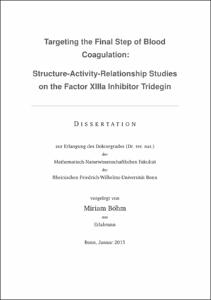Böhm, Miriam: Targeting the Final Step of Blood Coagulation : Structure-Activity-Relationship Studies on the Factor XIIIa Inhibitor Tridegin. - Bonn, 2015. - Dissertation, Rheinische Friedrich-Wilhelms-Universität Bonn.
Online-Ausgabe in bonndoc: https://nbn-resolving.org/urn:nbn:de:hbz:5n-41288
Online-Ausgabe in bonndoc: https://nbn-resolving.org/urn:nbn:de:hbz:5n-41288
@phdthesis{handle:20.500.11811/6536,
urn: https://nbn-resolving.org/urn:nbn:de:hbz:5n-41288,
author = {{Miriam Böhm}},
title = {Targeting the Final Step of Blood Coagulation : Structure-Activity-Relationship Studies on the Factor XIIIa Inhibitor Tridegin},
school = {Rheinische Friedrich-Wilhelms-Universität Bonn},
year = 2015,
month = sep,
note = {The prophylaxis and therapy of thrombotic diseases is one of the major columns supporting our continuously increasing life expectancy and health. The transglutaminase factor XIIIa (FXIIIa), which is part of the blood coagulation cascade, therefore is an interesting target for antithrombotic and thrombolytic treatment with enzyme inhibitors. Additionally, powerful and specific FXIIIa inhibitors are valuable research tools to elucidate the multiple functions of FXIIIa in more detail. An example for such a powerful inhibitor of FXIIIa can be found in nature: Tridegin, a 66mer peptide was first isolated from the salivary gland of the giant amazon leech Haementeria ghilianii in 1997 and is still one of the most potent and specific FXIIIa inhibitors described. The aim of this thesis is to gain access to the peptide by different preparation methods and to characterize in detail the inhibitory mechanism and structure of this interesting peptide. In the course of this research tridegin was synthesized by solid-phase peptide synthesis followed by oxidative self folding to form disulfide bonds. Additionally, recombinant expression of the peptide in Escherichia coli was performed. Functional analysis by enzyme activity and binding assays revealed that the major inhibitory action is localized in the C-terminal part of the peptide, whereas the N-terminal part contributes to binding affinity. The disulfide connectivity of both the synthetic and the recombinant peptide variant was elucidated by mass spectrometric analysis and showed that three different disulfide-linked isomers were formed. Subsequently, molecular modeling of all three isomers was performed and the models were docked to the FXIII-A° structure. In general, this work greatly increases the understanding of the natural FXIIIa inhibitor tridegin, which provides the scientific community with a valuable research tool and a potential lead structure for the development of new FXIIIa inhibitors.},
url = {https://hdl.handle.net/20.500.11811/6536}
}
urn: https://nbn-resolving.org/urn:nbn:de:hbz:5n-41288,
author = {{Miriam Böhm}},
title = {Targeting the Final Step of Blood Coagulation : Structure-Activity-Relationship Studies on the Factor XIIIa Inhibitor Tridegin},
school = {Rheinische Friedrich-Wilhelms-Universität Bonn},
year = 2015,
month = sep,
note = {The prophylaxis and therapy of thrombotic diseases is one of the major columns supporting our continuously increasing life expectancy and health. The transglutaminase factor XIIIa (FXIIIa), which is part of the blood coagulation cascade, therefore is an interesting target for antithrombotic and thrombolytic treatment with enzyme inhibitors. Additionally, powerful and specific FXIIIa inhibitors are valuable research tools to elucidate the multiple functions of FXIIIa in more detail. An example for such a powerful inhibitor of FXIIIa can be found in nature: Tridegin, a 66mer peptide was first isolated from the salivary gland of the giant amazon leech Haementeria ghilianii in 1997 and is still one of the most potent and specific FXIIIa inhibitors described. The aim of this thesis is to gain access to the peptide by different preparation methods and to characterize in detail the inhibitory mechanism and structure of this interesting peptide. In the course of this research tridegin was synthesized by solid-phase peptide synthesis followed by oxidative self folding to form disulfide bonds. Additionally, recombinant expression of the peptide in Escherichia coli was performed. Functional analysis by enzyme activity and binding assays revealed that the major inhibitory action is localized in the C-terminal part of the peptide, whereas the N-terminal part contributes to binding affinity. The disulfide connectivity of both the synthetic and the recombinant peptide variant was elucidated by mass spectrometric analysis and showed that three different disulfide-linked isomers were formed. Subsequently, molecular modeling of all three isomers was performed and the models were docked to the FXIII-A° structure. In general, this work greatly increases the understanding of the natural FXIIIa inhibitor tridegin, which provides the scientific community with a valuable research tool and a potential lead structure for the development of new FXIIIa inhibitors.},
url = {https://hdl.handle.net/20.500.11811/6536}
}






